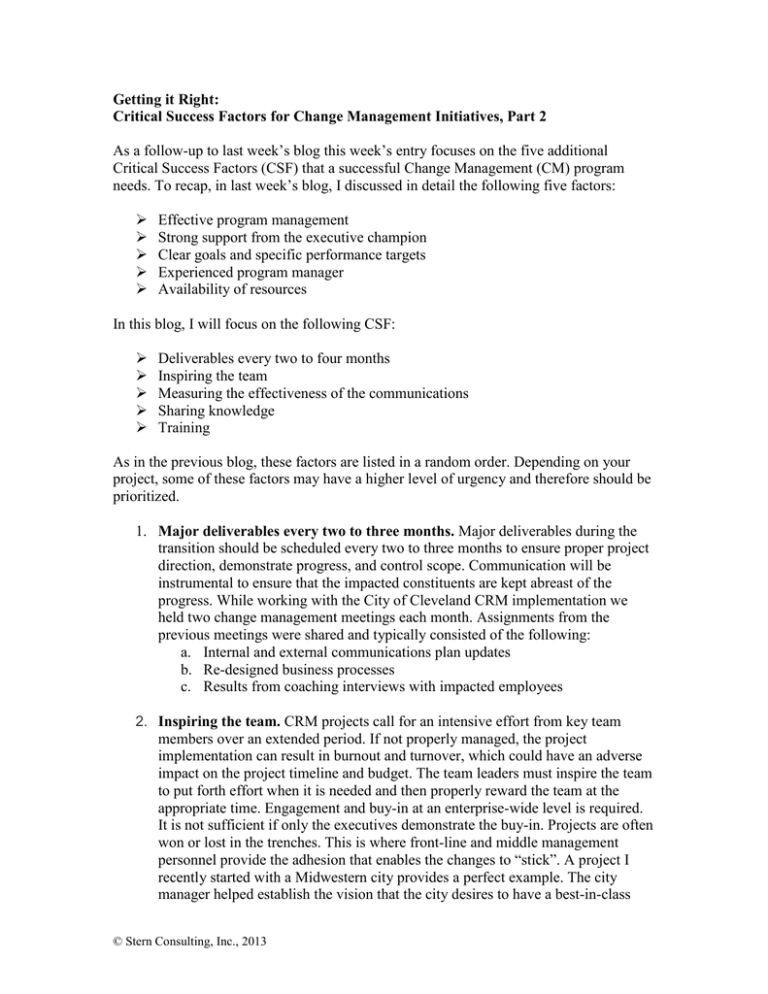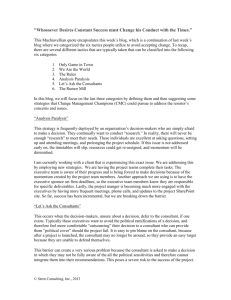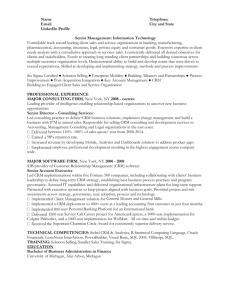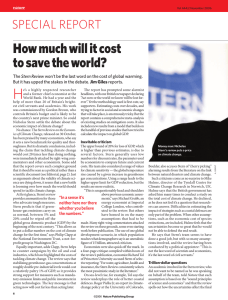Getting it Right: Critical Success Factors for Change Management
advertisement

Getting it Right: Critical Success Factors for Change Management Initiatives, Part 2 As a follow-up to last week’s blog this week’s entry focuses on the five additional Critical Success Factors (CSF) that a successful Change Management (CM) program needs. To recap, in last week’s blog, I discussed in detail the following five factors: Effective program management Strong support from the executive champion Clear goals and specific performance targets Experienced program manager Availability of resources In this blog, I will focus on the following CSF: Deliverables every two to four months Inspiring the team Measuring the effectiveness of the communications Sharing knowledge Training As in the previous blog, these factors are listed in a random order. Depending on your project, some of these factors may have a higher level of urgency and therefore should be prioritized. 1. Major deliverables every two to three months. Major deliverables during the transition should be scheduled every two to three months to ensure proper project direction, demonstrate progress, and control scope. Communication will be instrumental to ensure that the impacted constituents are kept abreast of the progress. While working with the City of Cleveland CRM implementation we held two change management meetings each month. Assignments from the previous meetings were shared and typically consisted of the following: a. Internal and external communications plan updates b. Re-designed business processes c. Results from coaching interviews with impacted employees 2. Inspiring the team. CRM projects call for an intensive effort from key team members over an extended period. If not properly managed, the project implementation can result in burnout and turnover, which could have an adverse impact on the project timeline and budget. The team leaders must inspire the team to put forth effort when it is needed and then properly reward the team at the appropriate time. Engagement and buy-in at an enterprise-wide level is required. It is not sufficient if only the executives demonstrate the buy-in. Projects are often won or lost in the trenches. This is where front-line and middle management personnel provide the adhesion that enables the changes to “stick”. A project I recently started with a Midwestern city provides a perfect example. The city manager helped establish the vision that the city desires to have a best-in-class © Stern Consulting, Inc., 2013 non-emergency call center. His passion translated into getting staff level excited by this vision and clamoring to play a meaningful role in the project. 3. Measuring the effectiveness of the communications. The organization should consider deploying a mechanism to assess the effectiveness of its communications effort. If this is absent, they will be unable to gauge if its messages are heard or understood. A set of performance metrics should be created to measure the tactic’s effectiveness. When I helped launch Baltimore’s CRM system, we utilized several communications tactics to share results. The ones that exhibited the “biggest bang for the buck” were those focusing on the financial metrics and cost savings that the city achieved. Since those appeared to resonate most with the target audiences, more financial-based marketing tactics were developed. 4. Sharing knowledge. Large-scale change projects create demands for new skills. Sharing knowledge among the project team members is a critical success factor in developing new skills and disseminating insight. Technology enables this. My clients in Carlsbad, CA and Elgin, IL have developed a simple-to-use SharePoint site to collaborate and share information. In addition, Elgin is investigating utilizing social media options such as You Tube and Facebook to distribute content on a real-time basis. 5. Training. Training is an opportunity to educate the organization’s staff and constituents about changes that a new project will deliver. In addition, it can serve as a feedback vehicle for the core change management team. Training can take on a number of different forms and channels. The training should focus on educating organization’s staff about the large-scale change. When developing the training program, individual learning styles should be considered. While working with Santa Ana, CA, the change management leaders utilized multiple forms of training including: a. Classroom/workshop-based b. Web-based, self-paced c. On-the-job d. Experiential Let me close with the following questions: 1 – Can you share any examples of the issues that arise when these factors are not followed? 2 – Can you think of other critical success factors? Tune in next week when we discuss how to select change management champions. © Stern Consulting, Inc., 2013 Spencer Stern specializes in assessing the business and process impact of new technology-based solutions, ranging from enterprise-wide software systems to wireless communications networks. In 2008 he launched Stern Consulting where he continues to focus on assessing the financial impact of large-scale municipal strategic implementations. He can be reached at: spencer@sternconsultinginc.com For more information, please visit: www.sternconsultinginc.com © Stern Consulting, Inc., 2013










